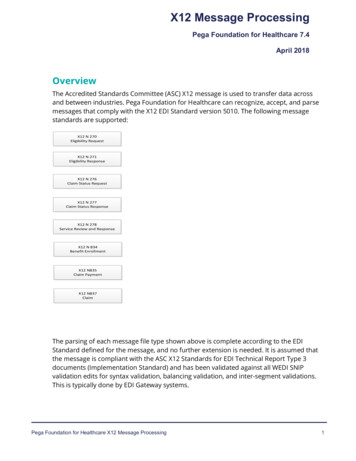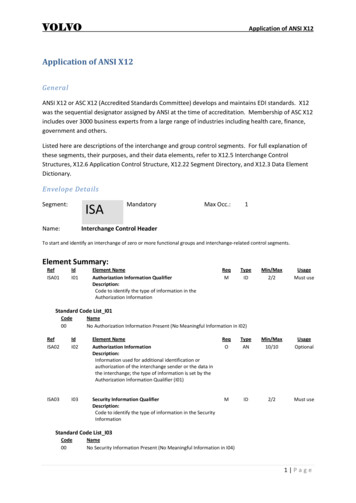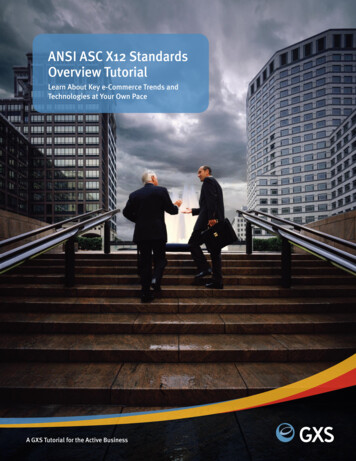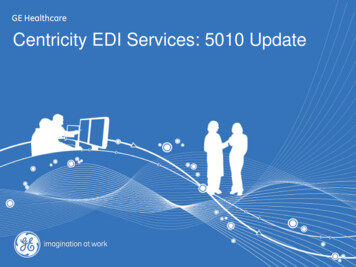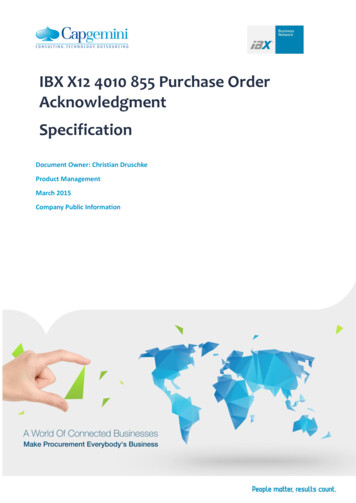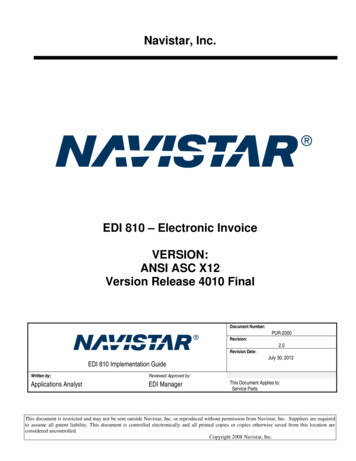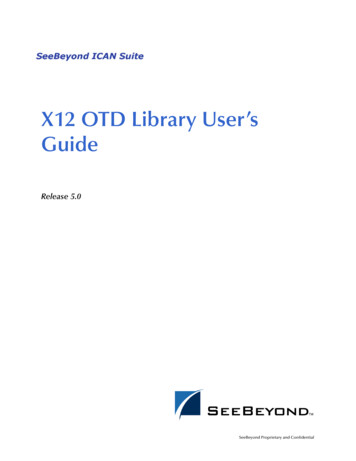
Transcription
X12 OTD Library User’sGuideRelease 5.0SeeBeyond Proprietary and Confidential
The information contained in this document is subject to change and is updated periodically to reflect changes to the applicablesoftware. Although every effort has been made to ensure the accuracy of this document, SeeBeyond Technology Corporation(SeeBeyond) assumes no responsibility for any errors that may appear herein. The software described in this document is furnishedunder a License Agreement and may be used or copied only in accordance with the terms of such License Agreement. Printing,copying, or reproducing this document in any fashion is prohibited except in accordance with the License Agreement. The contentsof this document are designated as being confidential and proprietary; are considered to be trade secrets of SeeBeyond; and may beused only in accordance with the License Agreement, as protected and enforceable by law. SeeBeyond assumes no responsibility forthe use or reliability of its software on platforms that are not supported by SeeBeyond.SeeBeyond, e*Gate, and e*Way are the registered trademarks of SeeBeyond Technology Corporation in the United States and selectforeign countries; the SeeBeyond logo, e*Insight, and e*Xchange are trademarks of SeeBeyond Technology Corporation. The absenceof a trademark from this list does not constitute a waiver of SeeBeyond Technology Corporation's intellectual property rightsconcerning that trademark. This document may contain references to other company, brand, and product names. These company,brand, and product names are used herein for identification purposes only and may be the trademarks of their respective owners. 2000–2003 by SeeBeyond Technology Corporation. All Rights Reserved. This work is protected as an unpublished work under thecopyright laws.This work is confidential and proprietary information of SeeBeyond and must be maintained in strict confidence.Version 20031121160609.X12 OTD Library User’s Guide2SeeBeyond Proprietary and Confidential
ContentsContentsList of Tables6List of Figures7Chapter 1Introduction8Overview8Intended Reader8Compatible Systems8Chapter 2X12 Overview10Introduction to X1210What Is X12?What Is a Message Structure?1011Components of an X12 Envelope11Data ElementsSegmentsLoopsDelimiters12121212Structure of an X12 Envelope13Transaction Set (ST/SE)Functional Group (GS/GE)Interchange Envelope (ISA/IEA)Control NumbersISA13 (Interchange Control Number)GS06 (Functional Group Control Number)ST02 (Transaction Set Control Number)15161718181919Backward Compatibility19Messages19Example of EDI Usage28Overview of EDI Payments ProcessingTypes of Information that Is Exchanged ElectronicallyX12 OTD Library User’s Guide32829SeeBeyond Proprietary and Confidential
ContentsTypes of Electronic PaymentTransfer of FundsPayment-Related EDI Transactions293031Acknowledgment Types31TA1, Interchange Acknowledgment997, Functional AcknowledgmentApplication Acknowledgments313132Key Parts of EDI Processing Logic32StructuresValidations, Translations, Enveloping, AcknowledgmentsTrading Partner AgreementsAdditional Information32333333Chapter 3X12 Template Installation35X12 Libraries35Installation Procedure36Uploading to the RepositoryRefreshing Enterprise Designer with eXchangeX12 Library Templates363738X12 OTDsTransaction Template Names3839Chapter 4Working With the X12 OTDs40Viewing an X12 OTD in the OTD Editor40Setting the Delimiters42Methods for Getting and Setting42Using Validation in the Java Collaboration Editor43Creating a Collaboration Rule to Validate an X12 OTD43Alternative Formats: ANSI and XML44XML Format for X12Setting the Java Collaboration to XML OutputPossible Differences in Output When Using Pass-Through444647Chapter 5X12 OTD Library Java setSegmentTerminatorX12 OTD Library User’s Guide494950504SeeBeyond Proprietary and Confidential
n (no parameters)performvalidation (boolean parameter)setXMLOutput (boolean isXML)515252535354555556IndexX12 OTD Library User’s Guide585SeeBeyond Proprietary and Confidential
List of TablesList of TablesTable 1Default Delimiters in X12 OTD Library13Table 2Transactions Included in X12 Version 401019Table 3Key Parts of EDI Processing32Table 4X12 Versions Supported35X12 OTD Library User’s Guide6SeeBeyond Proprietary and Confidential
List of FiguresList of FiguresFigure 1X12 Envelope Schematic14Figure 2X12 997 Segment Table15Figure 3X12 997 Viewed in OTD Editor15Figure 4Example of a Transaction Set Header (ST)16Figure 5Example of a Transaction Set Trailer (SE)16Figure 6Example of a Functional Group Header (GS)17Figure 7Example of a Functional Group Trailer (GE)17Figure 8Example of an Interchange Header (ISA)18Figure 9Example of an Interchange Trailer (IEA)18Figure 10Update Center Wizard: Select Modules to Install37Figure 11Some of the Transaction Set Structures for X12 Version 401038Figure 12X12 270 Transaction in the OTD Editor41Figure 13Accessing a Method in an X12 OTD43Figure 14Accessing the performvalidation Method from the Root Node44Figure 15XML X12 DTD45Figure 16X12 997 Functional Acknowledgment—XML46Figure 17X12 997 Functional Acknowledgment—ANSI Format46X12 OTD Library User’s Guide7SeeBeyond Proprietary and Confidential
Chapter 1IntroductionThis chapter introduces you to the X12 OTD Library User’s Guide.Note: If you are upgrading from version 4.5.1 or earlier, your Collaborations that use JavaETDs (now called OTDs) must be recompiled after installing the new version.1.1OverviewEach of the eGate Object Type Definition (OTD) libraries contains sets of pre-builtstructures for industry-standard formats.The X12 OTD library is one of the product within the SeeBeyond ICAN Suite. The OTDlibrary contains message definitions for X12 messages. This document gives a briefoverview of X12 and the X12 message structures provided with eGate, and providesinformation on installing and using the X12 OTD libraries.1.2Intended ReaderThe reader of this guide is presumed to be a developer or system administrator withresponsibility for maintaining the SeeBeyond ICAN Suite (and/or eGate Integrator andeXchange Integrator), to have familiarity with Windows operations and administration,and to be thoroughly familiar with Microsoft Windows graphical user interfaces.1.3Compatible SystemsThe X12 OTD Library is available on the following platforms: Microsoft Windows 2000 and Windows XP HP Tru64 UNIX Version 5.1A HP-UX 11.0 and HP-UX 11i (RISC) IBM AIX 5.1 and AIX 5.2 Red Hat Linux Advanced Server 2.1 (Intel version)X12 OTD Library User’s Guide8SeeBeyond Proprietary and Confidential
Chapter 1IntroductionSection 1.3Compatible Systems Sun Solaris 8 and Solaris 9Note: Windows Systems—References to “Windows” without further qualification applyto the Windows platforms noted: Windows XP and Windows 2000.Note: UNIX Systems—This guide uses the backslash (“\”) as the separator within pathnames. If you are working on a UNIX system, make the appropriate substitutions.X12 OTD Library User’s Guide9SeeBeyond Proprietary and Confidential
Chapter 2X12 OverviewThis chapter provides the following information: An overview of X12, including the structure of an X12 envelope, data elements, andsyntax. An explanation of how to use the generic message structures provided as an add-onto eGate to help you quickly create the structures you need for various X12transactions. An example of how X12 is used in payment processing.2.1Introduction to X12The following sections provide an introduction to X12 and to the message structuresthat constitute the X12 OTD Library.2.1.1.What Is X12?X12 is an EDI (electronic data interchange) standard, developed for the electronicexchange of machine-readable information between businesses.The Accredited Standards Committee (ASC) X12 was chartered by the AmericanNational Standards Institute (ANSI) in 1979 to develop uniform standards forinterindustry electronic interchange of business transactions—electronic datainterchange (EDI). The result was the X12 standard.The X12 body develops, maintains, interprets, and promotes the proper use of the ASCstandard. Data Interchange Standards Association (DISA) publishes the X12 standardand the UN/EDIFACT standard. The X12 body comes together three times a year todevelop and maintain EDI standards. Its main objective is to develop standards tofacilitate electronic interchange relating to business transactions such as orderplacement and processing, shipping and receiving information, invoicing, andpayment information.The X12 EDI standard is used for EDI within the United States. UN/EDIFACT isbroadly used in Europe and other parts of the world.X12 was originally intended to handle large batches of transactions. However, it hasbeen extended to encompass real-time processing (transactions sent individually asX12 OTD Library User’s Guide10SeeBeyond Proprietary and Confidential
Chapter 2X12 OverviewSection 2.2Components of an X12 Envelopethey are ready to send, rather than held for batching) for some healthcare transactionsto accommodate the healthcare industry.2.1.2.What Is a Message Structure?The term message structure (also called a transaction set structure) refers to the way inwhich data elements are organized and related to each other for a particular EDItransaction.In eGate, a message structure is called an Object Type Definition (OTD). Each messagestructure (OTD) consists of the following: Physical hierarchyThe predefined way in which envelopes, segments, and data elements areorganized to describe a particular X12 EDI transaction. DelimitersThe specific predefined characters that are used to mark the beginning and end ofenvelopes, segments, and data elements. PropertiesThe characteristics of a data element, such as the length of each element, defaultvalues, and indicators that specify attributes of a data element—for example,whether it is required, optional, or repeating.The transaction set structure of an invoice that is sent from one trading partner toanother defines the header, trailer, segments, and data elements required by invoicetransactions. Installation of X12 templates for a specific version includes transaction setstructures for each of the transactions available in that version. You can use thesestructures as provided, or customize them to suit your business needs.eXchange Integrator uses eGate Object Type Definitions, which are based on the X12message structures, to verify that the data in the messages coming in or going out is inthe correct format. There is a message structure for each X12 transaction.The list of transactions provided is different for each version of X12. This book usesVersion 4010 as an example in illustrating how to install and work with X12 templates.2.2Components of an X12 EnvelopeX12 messages are all ASCII text, with the exception of the BIN segment which is binary.Each X12 message is made up of a combination of the following elements: Data elements Segments LoopsElements are separated by delimiters.X12 OTD Library User’s Guide11SeeBeyond Proprietary and Confidential
Chapter 2X12 OverviewSection 2.2Components of an X12 EnvelopeMore information on each of these is provided below.2.2.1.Data ElementsThe data element is the smallest named unit of information in the X12 standard. Dataelements can be broken down into two types. The distinction between the two is strictlya matter of how they are used. The two types are: SimpleIf a data element occurs in a segment outside the defined boundaries of a compositedata structure it is called a simple data element. CompositeIf a data element occurs as an ordinally positioned member of a composite datastructure it is called a composite data element.Each data element has a unique reference number; it also has a name, description, datatype, and minimum and maximum length.2.2.2.SegmentsA segment is a logical grouping of data elements. In X12, the same segment can be usedfor different purposes. This means that a field’s meaning can change based on thesegment. For example: The NM1 segment is for any name (patient, provider, organization, doctor) The DTP segment is for any date (date of birth, discharge date, coverage period)For more information on the X12 enveloping segments, refer to “Structure of an X12Envelope” on page 13.2.2.3.LoopsLoops are sets of repeating ordered segments. In X12 you can locate elements byspecifying: The transaction set (for example, 270) The loop (for example, “loop 1000” or “info. receiver loop”) The occurrence of the loop The segment (for example, BGN) The field number (for example, 01) The occurrence of the segment (if it is a repeating segment)2.2.4.DelimitersIn an X12 message, the various delimiters act as syntax, dividing up the differentelements of a message. The delimiters used in the message are defined in theX12 OTD Library User’s Guide12SeeBeyond Proprietary and Confidential
Chapter 2X12 OverviewSection 2.3Structure of an X12 Envelopeinterchange control header, the outermost layer enveloping the message. For thisreason, there is flexibility in the delimiters that are used.No suggested delimiters are recommended as part of the X12 standards, but theindustry-specific implementation guides do have recommended delimiters.The default delimiters used by the SeeBeyond X12 OTD Library are the same as thoserecommended by the industry-specific implementation guides. These delimiters areshown in Table 1.Table 1 Default Delimiters in X12 OTD LibraryType of DelimiterDefault ValueSegment terminator (tilde)Data element separator* (asterisk)Subelement (component) separator: (colon)Repetition separator (version 4020 andlater) (plus sign)Within eXchange Integrator, delimiters are specified at the B2B protocol level. Thedelimiters you define are applied to all transaction types.If you do not specify delimiters, eXchange expects the default delimiters as shown inTable 1.Note: It is important to note that errors could result if the transmitted data itself includesany of the characters that have been defined as delimiters. Specifically, the existenceof asterisks within transmitted application data is a known issue in X12, and cancause problems with translation.2.3Structure of an X12 EnvelopeThe rules applying to the structure of an X12 envelope are very strict, to ensure theintegrity of the data and the efficiency of the information exchange.The actual X12 message structure has three main levels. From the highest to the lowestthey are: Interchange Envelope Functional Group Transaction SetA schematic of X12 envelopes is shown in Figure 1. Each of these levels is explained inmore detail in the following sections.X12 OTD Library User’s Guide13SeeBeyond Proprietary and Confidential
Chapter 2X12 OverviewSection 2.3Structure of an X12 EnvelopeFigure 1 X12 Envelope SchematicNote: The above schematic is from Appendix B of an X12 Implementation Guide.Figure 2 shows the standard segment table for an X12 997 (FunctionalAcknowledgment) as it appears in the X12 standard and in most industry-specificimplementation guides.X12 OTD Library User’s Guide14SeeBeyond Proprietary and Confidential
Chapter 2X12 OverviewSection 2.3Structure of an X12 EnvelopeFigure 2 X12 997 Segment TableFigure 3 shows the same transaction as viewed in the OTD Editor.Figure 3 X12 997 Viewed in OTD Editor2.3.1.Transaction Set (ST/SE)Each transaction set (also called a transaction) contains three things: A transaction set header A transaction set trailer A single message, enveloped within the header and footerX12 OTD Library User’s Guide15SeeBeyond Proprietary and Confidential
Chapter 2X12 OverviewSection 2.3Structure of an X12 EnvelopeThe transaction has a three-digit code, a text title, and a two-letter code; for example,997, Functional Acknowledgment (FA).The transaction is composed of logically related pieces of information, grouped intounits called segments. For example, one segment used in the transaction set mightconvey the address: city, state, postal code, and other geographical information. Atransaction set can contain multiple segments. For example, the address segment couldbe used repeatedly to convey multiple sets of address information.The X12 standard defines the sequence of segments in the transaction set and also thesequence of elements within each segment. The relationship between segments andelements could be compared to the relationship between records and fields in adatabase environment.Figure 4 Example of a Transaction Set Header (ST)ST*270*0159 Transaction SetIdentifier CodeTransaction Set ControlNumberFigure 5 Example of a Transaction Set Trailer (SE)SE*41*0159 Number ofIncluded Segments2.3.2.Transaction Set ControlNumberFunctional Group (GS/GE)A functional group is composed of one or more transaction sets, all of the same type,that can be batched together in one transmission. The functional group is defined by theheader and trailer; the Functional Group Header (GS) appears at the beginning, and theFunctional Group Trailer (GE) appears at the end. Many transaction sets can beincluded in the functional group, but all transactions must be of the same type.Within the functional group, each transaction set is assigned a functional identifiercode, which is the first data element of the header segment. The transaction sets thatconstitute a specific functional group are identified by this functional ID code.The functional group header (GS) segment contains the following information: Functional ID code (the two-letter transaction code; for example, PO for an 850Purchase Order, HS for a 270 Eligibility, Coverage or Benefit Inquiry) to indicate thetype of transaction in the functional group Identification of sender and receiver Control information (the functional group control numbers in the header and trailersegments must be identical) Date and timeX12 OTD Library User’s Guide16SeeBeyond Proprietary and Confidential
Chapter 2X12 OverviewSection 2.3Structure of an X12 EnvelopeThe functional group trailer (GE) segment contains the following information: Number of transaction sets included Group control number (originated and maintained by the sender)Figure 6 Example of a Functional Group Header X*004010X092 Functional ID codeDateTimeVersion/Release/Identifier CodeSender’s ID codeResponsible Agency CodeReceiver’s ID codeGroup control numberFigure 7 Example of a Functional Group Trailer (GE)GE*1*126 Number oftransaction sets2.3.3.Group controlnumberInterchange Envelope (ISA/IEA)The interchange envelope is the wrapper for all the data to be sent in one batch. It cancontain multiple functional groups. This means that transactions of different types canbe included in the interchange envelope, with each type of transaction stored in aseparate functional group.The interchange envelope is defined by the header and trailer; the Interchange ControlHeader (ISA) appears at the beginning, and the Interchange Control Trailer (IEA)appears at the end.As well as enveloping one or more functional groups, the interchange header andtrailer segments include the following information: Data element separators and data segment terminator Identification of sender and receiver Control information (used to verify that the message was correctly received) Authorization and security information, if applicableThe sequence of information that is transmitted is as follows: Interchange header Optional interchange-related control segments Actual message information, grouped by transaction type into functional groupsX12 OTD Library User’s Guide17SeeBeyond Proprietary and Confidential
Chapter 2X12 OverviewSection 2.3Structure of an X12 Envelope Interchange trailerFigure 8 Example of an Interchange Header *000515*1457*U*00401*000000028*0*T*: 789101112 13Interchange Header Segments from Figure 8:12345678 Time9 Repetition Separator10Interchange Control Version Number11Interchange Control Number12Acknowledgment Requested13Usage IndicatorAuthorization Information QualifierSecurity Information QualifierInterchange ID QualifierInterchange Sender IDInterchange ID QualifierInterchange Receiver IDDateFigure 9 Example of an Interchange Trailer (IEA)IEA*1*000000028 Number of includedfunctional groups2.3.4.Interchangecontrol numberControl NumbersThe X12 standard includes a control number for each enveloping layer: ISA13—Interchange Control Number GS06—Functional Group Control Number ST02—Transaction Set Control NumberThe control numbers act as identifiers, useful in message identification and tracking.eXchange Integrator includes a flag for each control number, so you can choose not toassign control numbers to outgoing messages and not to store control numbers onincoming messages.ISA13 (Interchange Control Number)The ISA13 is assigned by the message sender. It must be unique for each interchange.This is the primary means used by eXchange Integrator to identify an individualinterchange.X12 OTD Library User’s Guide18SeeBeyond Proprietary and Confidential
Chapter 2X12 OverviewSection 2.4Backward CompatibilityGS06 (Functional Group Control Number)The GS06 is assigned by the sender. It must be unique within the Functional Groupassigned by the originator for a transaction set.Note: The Functional Group control number GS06 in the header must be identical to thesame data element in the associated Functional Group trailer, GE02.ST02 (Transaction Set Control Number)The ST02 is assigned by the sender, and is stored in the transaction set header. It mustbe unique within the Functional Group.Note: The control number in ST02 must be identical with the SE02 element in thetransaction set trailer, and must be unique within a Functional Group (GS-GE).Once you have defined a value for SE02, eXchange Integrator uses the same valuefor SE02.2.4Backward CompatibilityEach version of X12 is slightly different. Each new version has some new transactions;in addition, existing transactions might have changed.New versions of X12 are usually backward compatible; however, this is not arequirement of the X12 rules. You should not expect different versions of X12 to bebackward compatible, but you can expect that when you analyze the differences only afew changes are required in the message structures.Note: In this context backward compatible means that software that parses one versionmight not be able to parse the next version, even if the software ignores anyunexpected new segments, data elements at the end of segments, and sub-elementsat the end of composite data elements. Not backward compatible means that requiredsegments can disappear entirely, data elements can change format and usage, andrequired data elements can become optional.2.5MessagesAn example of an X12 version is shown in Table 2. This table lists the transactions ofX12 version 4010.Table 2 Transactions Included in X12 Version 4010NumberTitle101Name and Address Lists104Air Shipment InformationX12 OTD Library User’s Guide19SeeBeyond Proprietary and Confidential
Chapter 2X12 OverviewSection 2.5MessagesTable 2 Transactions Included in X12 Version 4010 (Continued)NumberTitle105Business Entity Filings106Motor Carrier Rate Proposal107Request for Motor Carrier Rate Proposal108Response to a Motor Carrier Rate Proposal109Vessel Content Details110Air Freight Details and Invoice112Property Damage Report120Vehicle Shipping Order121Vehicle Service124Vehicle Damage125Multilevel Railcar Load Details126Vehicle Application Advice127Vehicle Baying Order128Dealer Information129Vehicle Carrier Rate Update130Student Educational Record (Transcript)131Student Educational Record (Transcript) Acknowledgment135Student Loan Application138Testing Results Request and Report139Student Loan Guarantee Result140Product Registration141Product Service Claim Response142Product Service Claim143Product Service Notification144Student Loan Transfer and Status Verification146Request for Student Educational Record (Transcript)147Response to Request for Student Educational Record (Transcript)148Report of Injury, Illness or Incident149Notice of Tax Adjustment or Assessment150Tax Rate Notification151Electronic Filing of Tax Return Data Acknowledgment152Statistical Government Information153Unemployment Insurance Tax Claim or Charge Information154Uniform Commercial Code Filing155Business Credit ReportX12 OTD Library User’s Guide20SeeBeyond Proprietary and Confidential
Chapter 2X12 OverviewSection 2.5MessagesTable 2 Transactions Included in X12 Version 4010 (Continued)NumberTitle157Notice of Power of Attorney159Motion Picture Booking Confirmation160Transportation Automatic Equipment Identification161Train Sheet163Transportation Appointment Schedule Information170Revenue Receipts Statement175Court and Law Enforcement Notice176Court Submission180Return Merchandise Authorization and Notification185Royalty Regulatory Report186Insurance Underwriting Requirements Reporting188Educational Course Inventory189Application for Admission to Educational Institutions190Student Enrollment Verification191Student Loan Pre-Claims and Claims194Grant or Assistance Application195Federal Communications Commission (FCC) License Application196Contractor Cost Data Reporting197Real Estate Title Evidence198Loan Verification Information199Real Estate Settlement Information200Mortgage Credit Report201Residential Loan Application202Secondary Mortgage Market Loan Delivery203Secondary Mortgage Market Investor Report204Motor Carrier Load Tender205Mortgage Note206Real Estate Inspection210Motor Carrier Freight Details and Invoice211Motor Carrier Bill of Lading212Motor Carrier Delivery Trailer Manifest213Motor Carrier Shipment Status Inquiry214Transportation Carrier Shipment Status Message215Motor Carrier Pick-up Manifest216Motor Carrier Shipment Pick-up NotificationX12 OTD Library User’s Guide21SeeBeyond Proprietary and Confidential
Chapter 2X12 OverviewSection 2.5MessagesTable 2 Transactions Included in X12 Version 4010 (Continued)NumberTitle217Motor Carrier Loading and Route Guide218Motor Carrier Tariff Information219Logistics Service Request220Logistics Service Response222Cartage Work Assignment223Consolidators Freight Bill and Invoice224Motor Carrier Summary Freight Bill Manifest225Response to a Cartage Work Assignment242Data Status Tracking244Product Source Information248Account Assignment/Inquiry and Service/Status249Animal Toxicological Data250Purchase Order Shipment Management Document251Pricing Support252Insurance Producer Administration255Underwriting Information Services256Periodic Compensation260Application for Mortgage Insurance Benefits261Real Estate Information Request262Real Estate Information Report263Residential Mortgage Insurance Application Response264Mortgage Loan Default Status265Real Estate Title Insurance Services Order266Mortgage or Property Record Change Notification267Individual Life, Annuity and Disability Application268Annuity Activity270Eligibility, Coverage or Benefit Inquiry271Eligibility, Coverage or Benefit Information272Property and Casualty Loss Notification273Insurance/Annuity Application Status275Patient Information276Health Care Claim Status Request277Health Care Claim Status Notification278Health Care Services Review Information280Voter Registration InformationX12 OTD Library User’s Guide22SeeBeyond Proprietary and Confidential
Chapter 2X12 OverviewSection 2.5MessagesTable 2 Transactions Included in X12 Version 4010 (Continued)NumberTitle285Commercial Vehicle Safety and Credentials Information Exchange286Commercial Vehicle Credentials288Wage Determination290Cooperative Advertising Agreements300Reservation (Booking Request) (Ocean)301Confirmation (Ocean)303Booking Cancellation (Ocean)304Shipping Instructions309U.S. Customs Manifest310Freight Receipt and Invoice (Ocean)311Canadian Customs Information312Arrival Notice (Ocean)313Shipment Status Inquiry (Ocean)315Status Details (Ocean)317Delivery/Pickup Order319Terminal Information322Terminal Operations and Intermodal Ramp Activity323Vessel Schedule and Itinerary (Ocean)324Vessel Stow Plan (Ocean)325Consolidation of Goods In Container326Consignment Summary List350U.S. Customs Status Information352U.S. Customs Carrier General Order Status353U.S. Customs Events Advisory Details354U.S. Customs Automated Manifest Archive Status355U.S. Customs Acceptance/Rejection356U.S. Customs Permit to Transfer Request357U.S. Customs In-Bond Information358U.S. Customs Consist Information361Carrier Interchange Agreement (Ocean)362Cargo Insurance Advice of Shipment404Rail Carrier Shipment Information410Rail Carrier Freight Details and Invoice414Rail Carhire Settlements417Rail Carrier Waybill InterchangeX12 OTD Library User’s Guide23SeeBeyond Proprietary and Confidential
Chapter 2X12 OverviewSection 2.5MessagesTable 2 Transactions Included in X12 Version 4010 (Continued)NumberTitle418Rail Advance Interchange Consist419Advance Car Disposition420Car Handling Information421Estimated Time of Arrival and Car Scheduling422Shipper's Car Order423Rail Industrial Switch List425Rail Waybill Request426Rail Revenue Waybill429Railroad Retirement Activity431Railroad Station Master File432Rail Deprescription433Railroad Reciprocal Switch File434Railroad Mark Register Update Activity435Standard Transportation Commodity Code Master436Locomotive Information437Railroad Junctions and Interchanges Activity440Shipment Weights451Railroad Event Report452Railroad Problem Log Inquiry or Advice453Railroad Service Commitment Advice455Railroad Parameter Trace Registration456Railroad Equipment Inquiry or Advice460Railroad Price Distribution Request or Response463Rail Rate Reply466Rate Request468Rate Docket Journal Log470Railroad Clearance475Rail Route File Maintenance485Ratemaking Action486Ra
X12 OTD Library User's Guide 8 SeeBeyond Proprietary and Confidential Chapter 1 Introduction This chapter introduces you to the X12 OTD Library User's Guide. Note: If you are upgrading from version 4.5.1 or earlier, your Collaborations that use Java ETDs (now called OTDs) must be recompiled after installing the new version. 1.1 Overview
